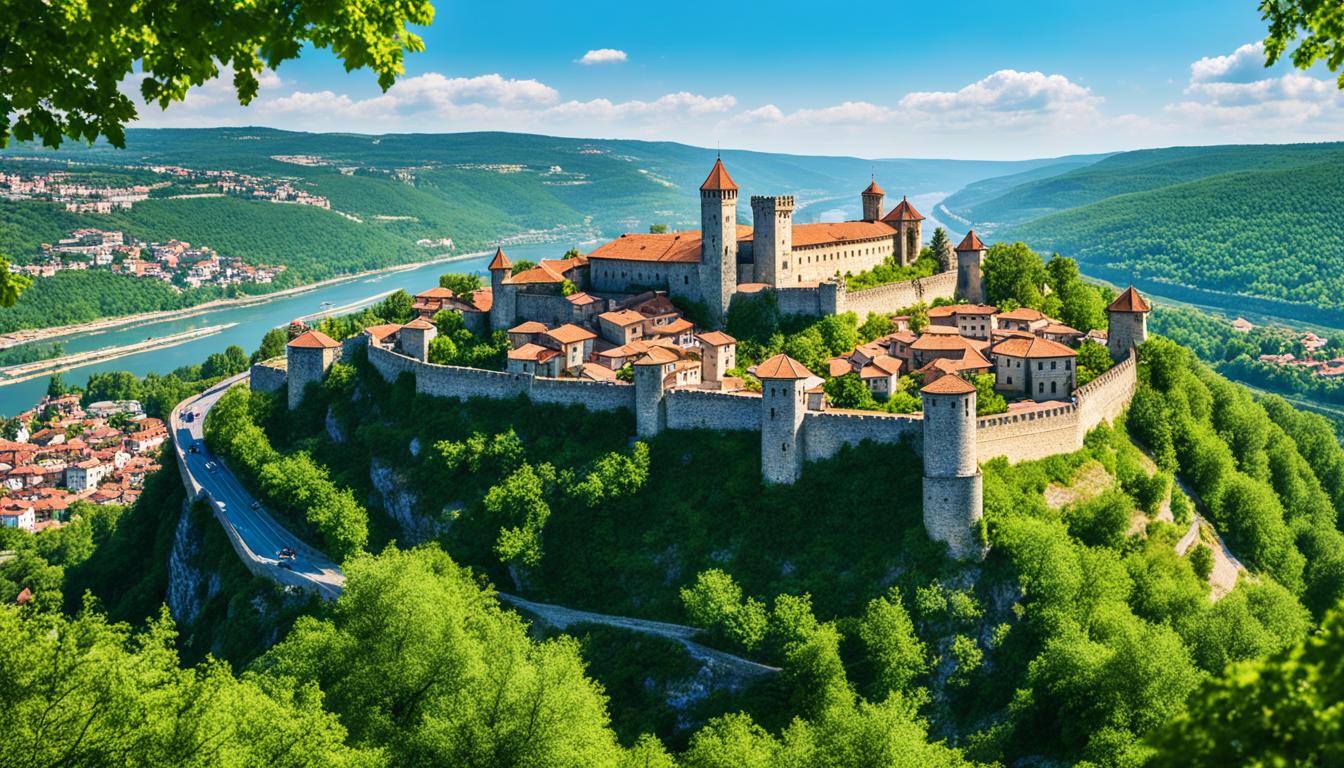Step Back in Time: Explore These Historical Landmarks in Bulgaria!
Have you ever wondered what secrets lie hidden within Bulgaria’s ancient ruins and storied towns? From towering medieval fortresses to quaint villages frozen in time, this captivating Balkan nation offers a wealth of historical landmarks that transport visitors on a journey through the ages.
Nestled in the heart of the Balkans, Bulgaria boasts a rich tapestry of cultural heritage that has endured for millennia1. The town of Koprivshtitsa, for instance, was declared a museum in 1952 to preserve its 388 architectural, historical, artistic, and ethnographic monuments, protected as a national reservation since 19711. Visitors can wander through the town’s well-preserved 19th-century houses, such as the Kableshkov House built in 1845, showcasing the architectural genius of the National Revival era1.
Beyond the charming old towns, Bulgaria’s historical landmarks encompass a diverse array of UNESCO World Heritage Sites, from the awe-inspiring Rila Monastery complex spanning 8,800 square meters2 to the ancient Thracian tombs that offer glimpses into the beliefs and practices of this enigmatic civilization3. Each destination promises an immersive experience, transporting visitors through the country’s captivating past.
Key Takeaways
- Discover Bulgaria’s rich cultural heritage through its well-preserved historical landmarks
- Explore ancient monasteries, fortresses, and UNESCO World Heritage Sites
- Uncover the stories of Bulgaria’s diverse past, from the Thracians to the National Revival era
- Immerse yourself in the charming atmosphere of Bulgaria’s historic towns and villages
- Witness the artistry and traditions that have endured for generations
Embark on a Journey Through Bulgaria’s Storied Past
Begin your exploration of Bulgaria’s history in the capital city of Sofia. Admire the stunning Alexander Nevsky Cathedral, an architectural marvel that stands as a symbol of the city’s rich Orthodox heritage. Venture up Vitosha Mountain, which offers breathtaking panoramic views of the city and a natural haven for outdoor enthusiasts. With a history stretching back thousands of years, Sofia’s diverse attractions invite visitors to uncover the layers of civilization that have shaped this captivating destination4.
Discover the ancient wonders of Plovdiv, Bulgaria’s second-largest city and one of the oldest continuously inhabited settlements in Europe. Explore the well-preserved Ancient Theatre of Plovdiv and the remarkable Roman Amphitheatre of Philippopolis, which have seamlessly transitioned from ancient relics to vibrant cultural hubs. Wander through the charming Old Town, where you’ll find layers of history and architectural gems that transport you back in time5.
Step into the medieval past of Bulgaria at the historic city of Veliko Tarnovo, the former capital of the Second Bulgarian Empire. Explore the Tsarevets Architectural and Museum Reserve, where the grandeur of the ancient fortress comes to life through a captivating Light and Sound Show. Nearby, the well-preserved Arbanasi Village offers a glimpse into the architectural and cultural heritage of the 17th and 18th centuries, with its unique stone houses and open-air museum experience6.
Historical Landmarks in Bulgaria: A Tapestry of Eras

Venture to the scenic Rila Mountains to discover the Rila Monastery, a UNESCO World Heritage Site and a cultural symbol deeply ingrained in Bulgaria’s identity7. This 10th-century monastery showcases the country’s rich spirituality and architectural prowess, with its brightly painted walls, towers, and intricate wood carvings7. Beyond its religious significance, the monastery also serves as an educational hub, featuring a museum with art, old books, and religious artifacts that offer insights into Bulgaria’s history and Orthodox traditions7. Nearby, other notable Bulgarian monasteries like Bachkovo Monastery, Troyan Monastery, and Rozhen Monastery are also worth exploring for their unique historical and architectural charms.
Discover the historical significance and stunning natural setting of the Belogradchik Fortress, which dates back to Roman times7. Perched amidst captivating rock formations, the fortress offers panoramic views that make for an unforgettable visit7. Venture further into Bulgaria’s subterranean wonders by exploring the awe-inspiring Devetashka Cave and Prohodna Cave, also known as the “Eyes of God.”7 These natural wonders in Bulgaria showcase the raw beauty of the country’s geological landscape and promise an extraordinary underground experience.
Bansko: A Mountain Retreat Steeped in Tradition

Nestled at the foot of the Pirin Mountains, the town of Bansko has evolved into Bulgaria’s premier mountain resort, offering a unique blend of modern amenities and rich cultural heritage8. Once a bustling center during the Bulgarian Renaissance, Bansko now preserves its history through a charming museum complex showcasing traditional houses, local crafts, and inspiring artworks8. Whether you visit in the winter to enjoy the snow-covered peaks and world-class ski facilities or in the warmer months to explore the scenic trails and natural wonders, Bansko promises an authentic and unforgettable experience8.
Indulge in the town’s delicious Bansko cuisine, featuring local specialties like Banski Starets, Kapama, and Bansko-style Barbecue (Kapriz), and unwind in the town’s rejuvenating Bansko spas after a day of outdoor adventure8. Bansko boasts8 16 slopes for skiing with a total length of more than 70 km, making it the most popular ski resort in Bulgaria8. Prestigious competitions such as the World Ski Cup and the World Snowboard Championship have been held in Bansko for several years, showcasing the resort’s good conditions for winter sports8.
Bansko is in close proximity to the Pirin National Park, offering natural attractions like horseback riding, buggy rides, rock climbing, rafting, kayaking, and fishing during warmer months8. Many hotels in Bansko offer packages with spa treatments included, catering to those seeking comfort and relaxation8. Hotels in Bansko offer authentic Bulgarian cuisine in their restaurants, further enhancing the visitor experience8.
Cultural events and festivals held throughout the year in Bansko attract interest from many visitors8. Bansko is located at the foot of the Pirin mountain range, enhancing the city’s natural beauty and tourism potential8. The Baikusheva mura tree near Bansko is more than 1300 years old and considered one of the oldest coniferous trees in Bulgaria8. Vihren Peak near Bansko, the second highest peak in Bulgaria at 2,914 meters, poses challenges for climbers due to steep sections and changing weather conditions8.
Conclusion
Bulgaria’s rich history and cultural heritage come alive through its captivating historical landmarks, from ancient ruins to medieval fortresses and picturesque old towns9. Whether you’re drawn to the architectural marvels of Sofia, the ancient wonders of Plovdiv, the medieval splendor of Veliko Tarnovo, or the natural and cultural gems of Bansko, this Balkan country offers a remarkable journey through time10. Immerse yourself in Bulgaria’s storied past and discover the layers of civilizations that have shaped this unique destination, creating an unforgettable travel experience.
From the 10th-century Rila Monastery9 to the ancient city of Plovdiv9, Bulgaria’s historical sites reflect the country’s diverse heritage and enduring traditions11. Explore the well-preserved old towns, marvel at the striking rock-hewn monasteries, and uncover the mysteries of the Thracian Tomb of Kazanlak9, all while immersing yourself in the warm hospitality and vibrant culture of the Bulgarian people.
Whether you’re a history buff, an architecture enthusiast, or simply seeking a unique travel experience, Bulgaria’s captivating historical landmarks offer a gateway to a bygone era10. Embark on this journey through time and create memories that will last a lifetime in this enchanting Balkan destination.







